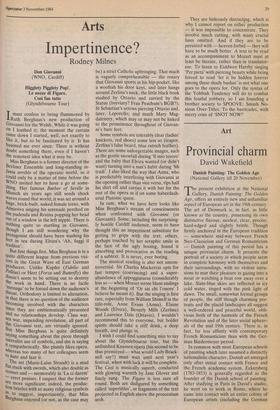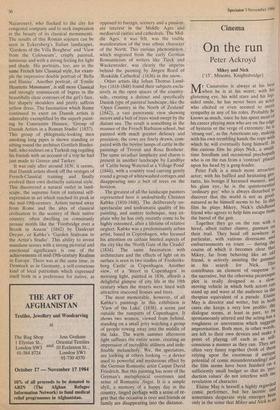Art
Provincial charm
David Wakefield
r'r he present exhibition at the National 1 Gallery, Danish Painting: The Golden Age, offers an entirely new and unfamiliar aspect of European art in the 19th century. The art of Denmark is, in fact, as little known as the country, possessing its own distinctive flavour, modest, clear, precise, hard-edged and slightly brittle. Though firmly anchored in the European tradition — somewhere mid-way between French Neo-Classicism and German Romanticism — Danish painting of this period has a unique provincial charm. It presents the portrait of a society in which people seem in complete harmony with themselves and their surroundings, with no violent intru- sions to mar their pleasure in gazing into a moat or watching a boat row away over a lake. Slate-blue skies are reflected in icy cold water, tinged with the pink light of dawn. The small, somewhat formal groups of people, the stiff though charming por- traits and the placid landscapes all suggest a well-ordered and peaceful world, obli- vious both of the turmoils of the French Revolution and of the later social upheav- als of the mid 19th century. There is, in fact, far less affinity with contemporary French Romanticism than with the Ger- man Biedermeyer period.
In common with most European schools of painting which later assumed a distinctly nationalistic character, Danish art emerged only after initial contact with France and the French academic system. Eckersberg (1783-1853) is generally regarded as the founder of the Danish school of painting. After studying in Paris in David's studio, he went on to work in Rome, where he came into contact with an entire colony of European artists (including the German Nazarenes). who flocked to the city for congenial company and to seek inspiration in the beauty of its classical monuments. The results of this Roman sojourn can be ,seen in Eckersberg's Italian landscapes, 'Gardens of the Villa Borghese' and 'View from the Colosseum', crisply painted, luminous and with a strong feeling for light and shade. His portraits, too, are in the same French late Classical style, for exam- ple the impressive double portrait of 'Bella and Hanna'. Another portrait, of 'Emilie Henriette Massmann', is still more Classical and strongly reminiscent of Ingres in the beautifully clear contours of the girl's face, her shapely shoulders and pretty saffron yellow dress. The fascination which Rome continued to exert on Danish artists is admirably exemplified by the superb paint- ing by Constantin Hansen, 'Group of Danish Artists in a Roman Studio' (1837). This group of phlegmatic-looking men smoking long pipes is shown standing or sitting round the architect Gottlieb Bindes- boll, who reclines on a Turkish rug regaling his friends with an account of a trip he had just made to Greece and Turkey.
It was only after around 1830, it seems, that Danish artists shook off the vestiges of French-Classical training and finally evolved their own distinctly national style. This discovered a natural outlet in land- scape, the supreme form of national self- expression in art which reached its peak in the mid-19th-century. Artists turned away from Rome and the sites of classical civilisation to the scenery of their native country, often dwelling on consciously prosaic motifs like the 'Footbridge over a Brook in Assens' (1842) by Dankvart Dreyer, or Kobke's 'Garden Staircase to the Artist's Studio'. This ability to invest mundane scenes with a strong pictorial and emotional significance is one of the achievements of mid-19th-century Realism in Europe. There was at the same time, in Denmark as in Germany, a self-conscious kind of local patriotism which expressed itself both in a preference for native, as opposed to foreign, scenery and a passion- ate interest in the Middle Ages and mediaeval castles and cathedrals. The Mid- dle Ages, it was felt, was the visible manifestation of the true ethnic character of the North. This curious phenomenon, which migrated from the early German Romanticism of writers like Tieck and Wackenroder, was clearly the impetus behind the painting by Jorgen Roed of 'Roskilde _Cathedral' (1836) in the snow.
Other artists like Johan Thomas Lund- bye (1818-1848) found their subjects exclu- sively in the open spaces of the country- side, creating a distinct and specifically Danish type of pastoral landscape, like the 'Open Country in the North of Zealand' (1842), a vast panoramic view showing moors and a belt of trees wind-swept by the distant sea. The result is something in the manner of the French Barbizon school, but painted with much greater delicacy and precision; the cows are finely drawn, com- pared with the bovine lumps of cattle in the paintings of Troyon and Rosa Bonheur. The same arcadian simplicity and charm is present in another landscape by Lundbye of 'Cattle being Watered at a Village Pond' (1844), with a country road curving gently round a group of whitewashed cottages and disappearing into a belt of trees on the horizon.
The greatest of all the landscape painters represented here is undoubtedly Christen Kobke (1810-1848). The deliberately un- spectacular and undramatic quality of his painting, and austere technique, may ex- plain why he has only recently come to be highly esteemed, after a lifetime of relative neglect. Kobke was a predominantly urban artist, based in Copenhagen, who focused his attention on certain limited aspects of the city like the 'North Gate of the Citadel' (1834). The same fascination with architecture and the effects of light on its surface is seen in two studies of 'Frederiks- borg Castle' in Copenhagen. Another view, of a 'Street in Copenhagen' in morning light, painted in 1836, affords a delightful glimpse of city life in the 19th century when the streets were lined with attractive stuccoed houses and trees.
The most memorable, however, of all Kobke's paintings in this exhibition is 'View of the Lake' (1838), a scene just outside the ramparts of Copenhagen. It shows two women, viewed from behind, standing on a small jetty watching a group of people rowing away into the middle of the lake. The warm summer afternoon light suffuses the entire scene, creating an impression of incredible stillness and inde- finable melancholy. We, the spectators, are looking at others looking — a device used to powerful and mysterious effect by the German Romantic artist Caspar David Friedrich. But this painting has none of the German's metaphysical overtones and sense of Romantic Angst. It is a simple idyll, a memory of a happy day in the country, tinged perhaps with a sense of re- gret that the occasion is over and friends or family are disappearing into the distance.











































 Previous page
Previous page